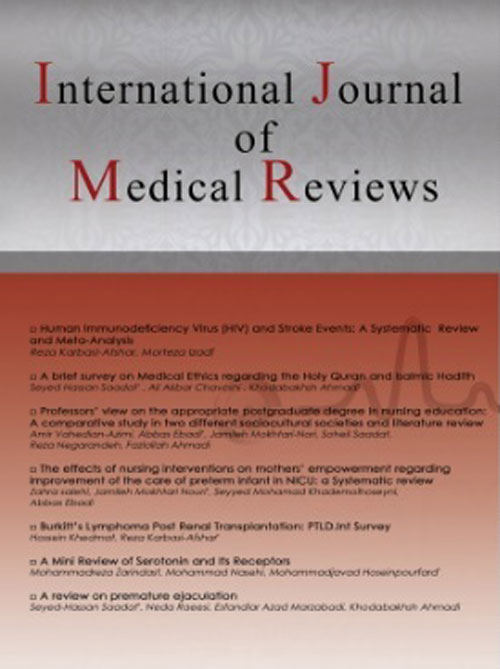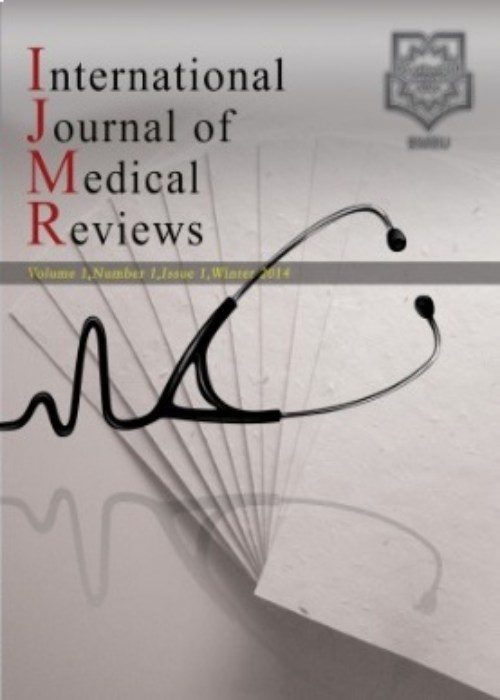فهرست مطالب

International Journal of Medical Reviews
Volume:2 Issue: 4, Autumn 2015
- تاریخ انتشار: 1394/09/16
- تعداد عناوین: 6
-
Page 297The Intensive Care Unit (ICU) is a paramount essential part of each hospital, which the most critically ill patients are treated and taken care by the highest experienced physicians and nurse's with the most advanced equipment in an appropriate and adequate space (1, 2). Those with different scopes of practice work more or less independently, in ways that might not best serve the needs of patients and their families (3). In such situations, lake of harmony, coordination, and consensus among the clinicians is the major source of human error, which is the eighth leading cause of deaths in the ICU (4). The applying shared decision making models (SDMMs), is one of the savior's approaches to harmonize and optimize the coordination and communication among the clinicians and can prevent the dreaded and catastrophic human errors. Shared decision making models have traditionally been understood to be the sharing of responsibility and control over medical decisions between patients, families, nurses, and physicians (5) and from many years ago, the models were introduced in the developed countries (6, 7).However, with many advantages and very minor disadvantages of SDMMs, the models remain in its infancy and significantly lag behind the progress made by developed countries in order to demonstrate the need for innovation. Furthermore, it should be stated why the models didnt get run in the developing countries and also, what the barriers and bridges of the commencing era of the SDMMs in the countries are.
-
Page 299IntroductionOne of the major advances in medical practice and healthcare is to incorporate decision support systems (DSS) in such practices to assist healthcare staff. The present study aimed to make a general understanding framework about state of the art clinical decision support systems (CDSS).MethodsThe design was systematic review. According to Research keywords (decision, decision-making, clinical decision, clinical decision-making, decision support, decision support system, clinical decision support system), Persian and English papers and scientific literature in scientific data bases include Simorgh, MagIran, and SID for Persian, as well as Science Direct, Google Scholar, Google Patent, Wikipedia, PubMed, Sage, and Springer for English resources were searched, so that from a basic sample of 1247 papers, 27 papers were selected regarding inclusion criteria. Delphi method was implemented to construct the final format of results report. The method of data analysis were librarian and content analysis.ResultsTwo main definitions of CDSS, 13 popular CDSSs, major aims of usage, practical and theoretical benefits, principal methods of decision support, three major classifications, medical/clinical data mining, EBM, and efficacy of CDSS have been evaluated and discussed.ConclusionThe usage of CDSS in clinical and healthcare settings is increasing. It has been shown that incorporation of CDSS can significantly improve health outcome indices. However, authorities shall establish standards and quality control systems to evaluate and integrate development and implementation procedures of CDSS. In addition, future studies would better head-to-head compare alike CDSS to evaluate competitive advantages and concurrent validity of various CDSSs.Keywords: Decision Support Systems (DSS), Clinical Decision Support Systems (CDSS), Multiple, criteria Decision Analysis (MCDA), Multiple, criteria Decision Making (MCDM), Medical, Clinical Data Mining, Evidence, Based medicine (EBM), Systematic Review, Delph
-
Page 309IntroductionAs a large part of human resources in the health system, nurses play an important role in promoting public health. One of the ways to provide better health services is training qualified nurses, and mastery learning would be one of the effective educational approaches to realize it. Despite its numerous advantages, the implementation of mastery learning is facing challenges. This study is to examine the effectiveness and the challenges of mastery learning.MethodsThis study is a systematic review with extensive search to find articles from Persian and English databases using the keywords of “education”, “health care research”, “evaluation”, “mastery learning”, “medical education”, and “nursing education” either alone or in combination with each other in the websites of Cumulative Index of Nursing and Allied Health Literature (CINAHL), Scopus, Medline, Embase, PsycINFO, and SID. 138 research papers published from 2005 to 2015 in line with the research question were found. After an examination, 16 articles were included in the study. The data from the articles were summarized, classified and analyzed based on the research question.ResultsAlthough mastery learning increases the educational effectiveness, its implementation for reasons such as the applicability to some subjects, time consumption, learners’ various individual characteristics, talented students’ lagging behind other learners, frequent formative assessments, and frequent test-designing require more efforts both by the teacher and the learners.ConclusionStudents raised through this method are competent students having the minimum requirements to perform their duties in the future. Therefore, proper curriculum design, introduction of this approach to teaching institutions and learners, empowerment of teachers, and pilot studies related to the solutions to address its challenges could help in exploiting this approach in theoretical and clinical education.Keywords: Mastery Learning, Nursing Education, Competency, Based Education
-
Page 317IntroductionDetection of errors is known as the basis for maintaining and improving patient safety. In this regard, patient safety is a key priority in the health system. Reporting medication errors, in addition to preventing potential harm to the patient, is also considered as a valuable information source for preventing further similar mistakes in the future. Although, there are many benefits and high ethical standards for medication error reports, nurses may have often some doubts in detecting errors for a patient in order to protect themselves from punishment and administrative rules. Thus, paying attention to barriers of reporting and resolving them is essential to the extent possible. This review study has been conducted with the aim of investigating the reasons why nurses refuse to report medication errors in Iran.Materials And MethodThis review study was conducted by surveying the studies between 1387-1393 using the keyword words reporting medication errors, Iran, barriers to reporting, and systematic review. All possible combinations of key words have been used in the databases such as Iran Medex, SID, Iran doc and Magiran using Google search engine. These combination were searched for according to Cochran's seven-step model regarding the inclusion criteria, including descriptive articles published in credited journals on the subject of barriers of nurses to report medication errors and the exclusion criteria, including qualitative studies, case reports, review studies, studies irrelevant to nurses’ medication errors, seminars as well as joint studies with other members of the treatment team.FindingsFrom among 18 studies retrieved, a number of eight studies were excluded from the study regarding the exclusion criteria, and finally 10 articles were analyzed. After analysis of the studies, reporting barriers were divided in three areas related to reporting, management factors, and fear from the reporting consequences.ConclusionThe results showed that the main barrier for not reporting medication errors is fear from managers and nurse educators’ inappropriate feedbacks as well as fear from financial and legal matters. Therefore, medication errors can be reduced by proper planning and management, away from punishment and reprimands, encouragements such as financial rewards, vacation incentives and so on, along with academic and in-service training, and creating a positive learning environment. Moreover, the implementation of a reporting error system in which the personnel feel safe is among other duties of this field.Keywords: Barriers, Reporting, Medical Errors, Nurse, Iran, Review, Systematic
-
Page 323Introductionnausea and vomiting due to chemotherapy is the most common and severe complications in patients suffering from cancer. This study is done with the aim of designing evidence-based nursing care instruction in nausea and vomiting of the patients suffering from chemotherapy.MethodsIt’s adevelopment study method in chemotherapy ward of Baqiatallah(A.J) hospital in 2014. Nausea and vomiting nuFrsing care instruction was designed based on the Stetler Model with evidence-based approach. The ideas of ten faculty members of the selected universities were considered for assessing the validity of the instruction content through Delphi model. Applicability of the instruction was assessed through interview with 8 relevant clinical experts. In addition to assessing nursing reference books, some articles were studied from some websites including: Google scholar, Elsevier, Cochran, Proquest, Pubmed and SID; the key words for searching these articles included; care instruction, evidence-based nursing, nausea, vomiting and protocol.Findingsin this study, the evidence-based instruction of nausea and vomiting due to chemotherapy included; nursing diagnosis, reasons, evaluation criteria and nursing interventions in this study;they can be used as a clinical guide for taking care of the patients undergoing chemotherapy based on the most valid scientific texts with evidence-based approach.Conclusiondesigning evidence-based nursing care instruction in patients undergoing chemotherapy leads to more benefits and increased achievement of the nursing staff to up-to-date information and finally increased nursing cares quality,in addition a part of clinical nurses’ need in facing nausea and vomiting in these patients will be met.Keywords: Instruction, Evidence, Based Nursing Care, Chemotherapy, Nausea, Vomiting
-
Page 331IntroductionMultiple Local and systemic factors can result in loss of teeth. Objectives of this review, is determining common systemic diseases can lead to tooth mobility or early tooth loss.MethodsThis study was a narrative review which reviewed the studies published between 1978 and 2014 by using electronic, academic and scientific resources. With this key words: Tooth Mobility, Systematic Disease, Tooth Loss. At the end, the collected data were simply content analysed.ResultsIn this study 17 common systemic disease were identified, as follows: 1.Diabetes Mellitus, 2.Female Sexual Hormones Condition, 3.Hyperpituitarism, 4. Hyperthyroidism, 5.Primary, Hyperparathyroidism, 6.Osteoporosis, 7.Hypophosphatasia, 8.Hypophosphatemia, 9.Acatalasia, 10.Erythromelalgia, 11.Gorham’s Disease, 12.Sarcoidosis, 13.Wegener’s Granulomatosis, 14.Burkitt, Lymphoma, 15.Non Hodgkin Lymphoma, 16.Multiple Myeloma, 17.Langerhans Cell Histiocytosis.ConclusionThe recognition of these common systemic diseases and links between doctors and dentists can limit or reduce the speed and extension of oral complication with fast and accurate oral health measures.Keywords: Tooth Mobility, Systematic Disease, Tooth Loss


